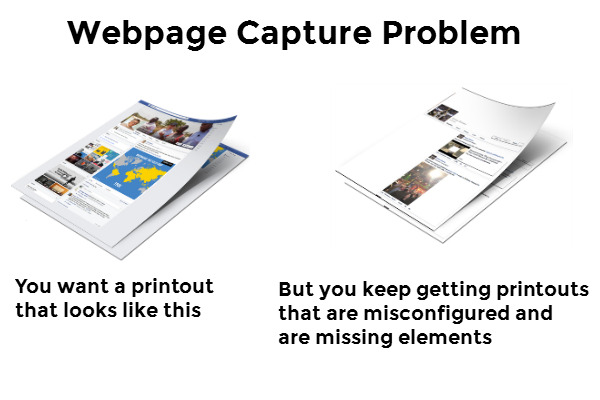The Need For Better Webpage Capture Products For Legal Professionals
The Internet is now the place where, for many, life happens. How do legal professionals record evidence in this new format?
 The Internet has become our new public forum. We advertise, sell, shop, publish, bank, flirt, and more. It offers every person a public platform that can be seen by millions. The Internet is now the place where, for many, life happens.
The Internet has become our new public forum. We advertise, sell, shop, publish, bank, flirt, and more. It offers every person a public platform that can be seen by millions. The Internet is now the place where, for many, life happens.
But has the legal world kept up with this development? How do legal professionals record evidence in this new format?
“It’s crazy, what we’ve seen some legal professionals still doing,” says Patrick Schweihs, attorney and VP of Customer Solutions at Page Vault. “The same person who buys best-in-class software for e-discovery or practice management is still limping along with webpage capture methods that are unreliable, unwieldy, and that introduce undue risk into their case.”
Here Today, Gone Tomorrow
Unlike other mediums, such as newspapers or other printed materials, a webpage can be easily altered or removed without leaving a trace of the former version. An attorney’s webpage capture may be the only record of the way a page appeared on a given date and time. Users often delete material, or even whole accounts, to protect themselves. In some cases, counsel has even directed clients to “clean up” their accounts and delete potentially damaging evidence. In some of these cases, counsel has been sanctioned for spoliation.
Legal professionals can’t rely on social media companies to divulge individual users’ deleted information. The Stored Communications Act (SCA) blocks subpoenas for content from social media companies such as Facebook. The main exception to the SCA is for law enforcement agencies involved in criminal cases.
Discovery requests made to a user’s private account are also unreliable. Requests for specific material may not be fulfilled. Further, best practices for discovery on social media are still in flux. Should attorneys be allowed to access all private information? How should a legal professional go about recording that information? In a recent case, material from a Facebook account was transcribed onto loose-leaf paper in fulfillment of a production request. This low-tech transcribing method may have included the substance of the posts, but how can that paper be authenticated in court?
 What is Necessary for Legal-Grade Webcaptures
What is Necessary for Legal-Grade Webcaptures
First, the capture should depict the page exactly as it appeared in the viewer’s browser. The capture should include all text and graphic elements in their original arrangement. In most cases, a capture of the entire page, top-to-bottom, is desirable for completeness.
Metadata should be thoroughly recorded for every capture. This includes URL, the IP address, the time and date of capture, the person making the capture, and the tool used for capturing. The page’s source code may also be necessary in specific circumstances. Thorough metadata records are important as the court may require an affidavit or testimony from the person who captured the webpages.
Legal professionals dealing with webpage evidence also need to keep a record of the digital chain-of-custody, the record of preservation of evidence from collection to presentation in court. The goal is to show that the evidence presented to the court is the same as what was originally collected, and that the evidence was preserved without tampering or alteration.
Current Capture Methods are Inadequate for Legal Use
Most current methods of capturing webpages for legal use are inadequate: they are unwieldy, time-consuming, and usually fail to preserve metadata and a digital chain of custody.
Legal professionals currently use one of three methods (or a combination) to capture webpages: print screen, print from browser, or screen capture utilities/browser plug-ins. Relying on the print-screen method is very time-consuming, especially for long social media pages. A person must paste, arrange, and edit the image into a document for their screen captures: a lengthy and error-prone task.
Printouts via a browser’s print function are faster than print-screens, but often fail to capture all of the content from a webpage. Typically, the printouts do not present the page as it appeared in the browser. Many webpages include code that allows the browser to only print parts of the page, and some sites even use such code to prevent viewers from printing altogether: websites offering counterfeit luxury goods for sale sometimes employ this trick.
If a case requires numerous webpages, or even a whole site to be captured (every page in a domain), these problems are magnified by volume.
There are a number of screen capture utilities available, but most such tools are not specifically designed for legal use: some capture only parts of pages, while others fail to render the page in its actual configuration. Few record metadata or document the digital chain of custody.
The Need is Clear
Ideally, legal professionals require a webpage capture tool that:
- Is used easily by attorneys, or even their clients, to quickly capture crucial pages before they disappear or change;
- Accurately represents the page and presents it in a standardized format such as a PDF;
- Records metadata, including time of capture and URL (and possibly source code);
- Time-stamps and digitally signs captures immediately in order to provide a digital chain of custody; and
- Can handle high volumes of webpage captures.







